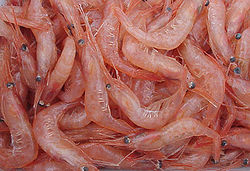Chitosan
In 1799, British chemist Charles Hatchett experimented with decalcifying the shells of various crustaceans, finding that a soft, yellow and cartilage-like substance was left behind that we now know to be chitin.
[1] Chitosan is produced commercially by deacetylation of chitin, which is the structural element in the exoskeleton of crustaceans (such as crabs and shrimp) and cell walls of fungi.
[3][4][5] A common method for obtaining chitosan is the deacetylation of chitin using sodium hydroxide in excess as a reagent and water as a solvent.
[19] Additionally, to enhance the solubility of chitosan-based hydrogels at neutral or alkaline pH, the derivative N-methylene phosphonic acid chitosan (NMPC-GLU) has been developed.
This material maintains good mechanical strength and improve cell proliferation, making it valuable for biomedical applications.
During this process, thioglycolic acid and cysteine mediate the reaction, forming an amide bond between the thiol group and chitosan.
Cationic derivatives of chitosan have important roles in bioadhesion, absorption enhancement, anti-inflammatory, antibacterial and anti-tumor applications.
[43] The biological properties of chitosan are closely related to its physicochemical structure, which includes the degree of deacetylation, water content, and molecular weight.
[44][better source needed] Chitosan inhibits the growth of different bacteria and fungi by mechanisms involving several factors, including the degree of deacetylation, pH, divalent cations, and solvent type.
Subsequent changes occur in cell membranes, chromatin, DNA, calcium, MAP kinase, oxidative burst, reactive oxygen species, callose pathogenesis-related (PR) genes, and phytoalexins.
[49] In the European Union and United Kingdom, chitosan is registered as a "basic substance" for use as a biological fungicide and bactericide on a wide range of crops.
[52] The biocontrol mode of action of chitosan elicits natural innate defense responses within plant to resist insects, pathogens, and soil-borne diseases when applied to foliage or the soil.
[61] NASA results revealed chitosan induces increased growth (biomass) and pathogen resistance due to elevated levels of β-(1→3)-glucanase enzymes within plant cells.
[63] A natural chitosan elicitor solution for agriculture and horticultural uses was granted an amended label for foliar and irrigation applications by the EPA in 2009.
[68] In combination with bentonite, gelatin, silica gel, isinglass, or other fining agents, it is used to clarify wine, mead, and beer.
Added late in the brewing process, chitosan improves flocculation, and removes yeast cells, fruit particles, and other detritus that cause hazy wine.
[71][72] Fungal source chitosan has shown an increase in settling activity, reduction of oxidized polyphenolics in juice and wine, chelation and removal of copper (post-racking) and control of the spoilage yeast Brettanomyces.
[76][77] Chitosan may have other properties conducive to wound healing, including antibacterial and antifungal activity, which remain under preliminary research.
[79] Chitosan is dissolved in dilute organic acid solutions but is insoluble in high concentrations of hydrogen ions at pH 6.5 and is precipitated as a gel-like compound.
[81] Chitosan and derivatives have been explored in the development of nanomaterials, bioadhesives, wound dressing materials,[82][42][75][3] improved drug delivery systems,[83][3] enteric coatings,[84] and in medical devices.
[99][100] Unlike other plant-based bioplastics (e.g. cellulose, starch), the main natural sources of chitosan come from marine environments and do not compete for land or other human resources.
[105][107] In 2015, the U.S. Food and Drug Administration issued a public advisory about supplement retailers who made exaggerated claims concerning the supposed weight loss benefit of various products.
[108] Microbial contamination of food products accelerates the deterioration process and increases the risk of foodborne illness caused by potentially life-threatening pathogens.
[109] Biodegradable chitosan films have potential for preserving various food products, retaining their firmness and restricting weight loss due to dehydration.
In addition, composite biodegradable films containing chitosan and antimicrobial agents are in development as safe alternatives to preserve food products.
[109] Chitosan is being investigated as an electrolyte for rechargeable batteries with good performance and low environmental impact due to rapid biodegradability, leaving recycleable zinc.





